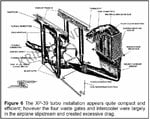Getting back on topic: one reason the P-39 turbo-charger installation didn't work was because of the bulky external side mounted intercooler and the drag it created. This was attributable to the fact that it didn't use a water cooled intercooler (like the Merlin). Had a water cooled itercooler have been used I assume only an enlarged or deepened radiator would have been needed.
It seems odd that a water cooled engine was compelled to not use a water cooled radiator.
It seems odd that a water cooled engine was compelled to not use a water cooled radiator.


